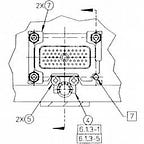One of the more unusual modules we have encountered is the 70612A K52 Power Amplifier module. Despite having a MSIB connector on the rear, power and switch control is supplied via a DB-9 connector, and the MSIB connector pins are only used to control a relay that ensure that the amplifier is only powered when the MMS mainframe is also powered on.
Unfortunately, no documentation could be found for this module, so we opened it up to find out what components were used inside:
Here the input and output connectors on the front are routed through a 33312A RF switch, which allows the amplifier to be bypassed.
At the rear of the module is the amplifier module, with a circulator to prevent backfeed into the amplifier.
The circulator is a Channel Microwave L620, with a bandwidth of 1–2 GHz.
The amplifier module is a Tron-Tech PF1020–33. Since Tron-Tech was acquired two decades ago, we were unable to find any technical documentation for this module.
Fortunately, we were able to figure out that the amplifier requires 24 vdc on pin 4 and ground on pin 5 of the DB-9 connector. The RF switch is connected to pins 1, 2, 3, with pin 1 being out (gnd), pin 2 being common (24vdc), and pin 3 being in (gnd). The amplifier module draws two amps of current when running.
To test the gain and frequency response of the amplifier, we connected the 70612A K52 module up to a HP70K spectrum analyzer with a 70300A tracking generator. This allowed us to sweep the amplifier to determine its linearity and frequency response.
The output from the 70300A tracking generator is connected to the amplifier input on the 70612A K52 module. The output from the 70612A K52 module is then connected to the input of the 70904A RF section. The downconverter and frequency generator in the upper 70001A mainframe are not used for this test.
When tested with an input signal at -50 dbm and -40 dbm, the power level was quite flat between 1 and 2 GHz, with a gain of 30 dbm being measured. Based on these measurements, we concluded that the “1020–33" in the Tron-Tech product name means 1.0 Ghz to 2.0 Ghz at 33 dbm.
This provides a good example of how a HP70K system can be used to characterize an unknown amplifier’s frequency response. Testing filters also uses the same procedure.
